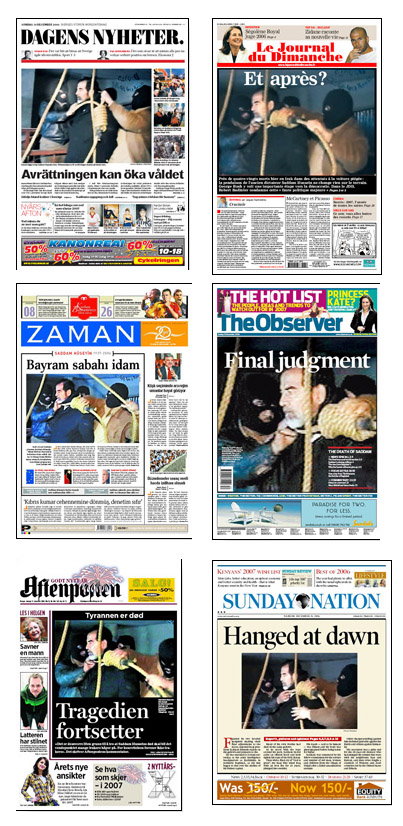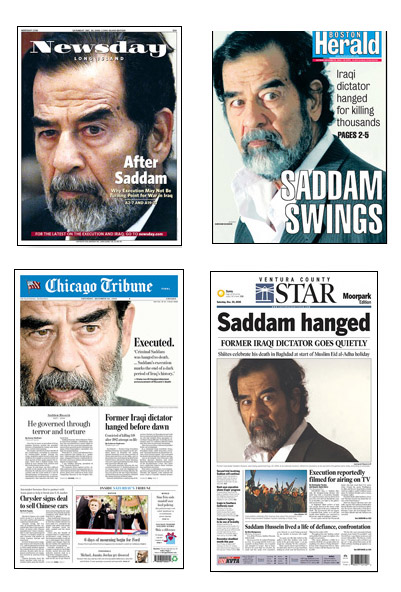 Ever since Josh Wolf was thrown in jail in August of 2006, a debate has raged about his job title. Is Wolf -- the 24-year-old freelance videographer, blogger, and activist who was jailed for refusing to hand over footage of a 2005 anarchist protest in San Francisco -- a "journalist"? Imprisoned for 226 days, longer than any other American journalist facing similar accusations, Wolf was released April 3 after complying with a subpoena and posting the (rather unremarkable) video on his website. That didn't calm questions about whether Wolf is a journalist and, therefore, whether he should've been protected by California's "shield" law which protects journalists who are trying to keep unnamed sources or interview notes private.
Ever since Josh Wolf was thrown in jail in August of 2006, a debate has raged about his job title. Is Wolf -- the 24-year-old freelance videographer, blogger, and activist who was jailed for refusing to hand over footage of a 2005 anarchist protest in San Francisco -- a "journalist"? Imprisoned for 226 days, longer than any other American journalist facing similar accusations, Wolf was released April 3 after complying with a subpoena and posting the (rather unremarkable) video on his website. That didn't calm questions about whether Wolf is a journalist and, therefore, whether he should've been protected by California's "shield" law which protects journalists who are trying to keep unnamed sources or interview notes private.Local experts, including the St. Cloud-based chair of Wolf's defense fund at the national Society for Professional Journalists, think he is, and they see his case, problematic as it may be, as a key fight to defend journalistic ethics -- and a reporter now defying a handover request from a judge in Mankato, Minn.
On July 8, 2005, Wolf grabbed his video camera to document a rally in San Francisco's Mission district held by local anarchists to coincide with a globalization conference happening concurrently in Scotland. During the protest, a police officer's skull was fractured, and there was allegedly an attempt to torch a police car. Wolf sold some of his footage of the day to local TV stations.
In the investigation that followed, a grand jury subpoenaed Wolf to turn over raw video footage and testify before the grand jury about its contents. (Around 65 subpoenas for journalists have been approved by the U.S. Attorney General since 2001.) Citing the First Amendment, his commitment to protecting the confidentiality of sources, and a belief that the media shouldn't be a tool of law enforcement, he refused -- and wound up in jail.
So. Is Wolf a "journalist" deserving protection under shield laws? Or does his unabashed activism and identification as an anarchist mean he's crossed the line between objectivity, the journalist's professed stock and trade, and advocacy.
Anthony Lappe of the progressive Guerrilla News Network said that Wolf's "oeuvre as a journalist, radical or not, is thin" consisting mainly of "online rants and what I call 'protest porn' -- contextless video of radical protests." And the conservative San Francisco Chronicle columnist Debra Saunders renders verdict in a piece with a title that says it all: "A journalist in his own mind."
She writes:
The editorial board at Saunders' paper disagreed with her assessment. "The fact that Josh Wolf has strong political views does not disqualify him from being a journalist any more than the fact that I am an editorial page editor and have opinions disqualifies me from being a journalist," said John Diaz of the San Francisco Chronicle in an interview with Kevin Sites. "The fact is, he was out at that rally, collecting information to disseminate to the public. I think that makes him a journalist."The issue here is whether Wolf should be protected by shield laws designed to protect real journalists who need to protect their sources. In Wolf's ideal world, he would qualify, not because he follows journalistic practices, but because he disseminates information to the public.
Of course, Wolf's cause appeals to the liberal sensibilities of the Special City. If a kid anarchist is willing to go to jail because he thinks he's a journalist, he must be a journalist. He feels so strongly about it. Damn the consequences.
Except a federal shield law that would protect Wolf also would protect an anti-abortion activist with a camera who attends an anti-abortion demonstration that turns violent and tapes activists as they pummel abortion clinic workers.
I asked Wolf: Should an anti-abortion blogger be able to use a shield law to protect the identity of an activist who beat up a clinic worker? He answered, "There should be some level of protection, yes."
Press freedom groups like Reporters without Borders and the Society of Professional Journalists -- an organization that, through its northern California chapter, nominated Wolf Journalist of the Year -- agree. The SPJ gave $31,000 to Wolf's legal defense, its largest donation ever for such a case, according to Dave Aiekens, a 13-year reporter at the St. Cloud Times and chair of the national defense fund. "The case is far from perfect," he acknowledged, "but they never are."While the SPJ stood firmly behind Wolf, it has no interest in the is-he-a-journalist question.
“The minute you start defining who’s a journalist you go down a tricky path of the government licensing journalists," Aiekens said. "We don’t think the government should have anything to say about it."
He added that because Wolf was shooting video and providing it to TV news stations, and has an established history of doing so, that qualifies him as a journalist.
For the sake of argument, would terrorists who videotape beheadings and bombings and send the footage to broadcast outlets then fall into that category? I'd argue no. While the subjects Wolf has taped often are masked, Wolf isn't. He posts his videos and sells footage to news stations under his own name, and the activities he's recorded -- at least in the case of the disputed clips of the San Francisco rally, which include no imagery of arson or violence -- conceal nothing criminal, as far as I can tell.
The burden of proof should fall on those who wish to disprove Wolf is a journalist. And who should do that? Certainly not the government, as Aiekens said. Jane Kirtley, director of the University of Minnesota's Silha Center for Media Ethics & Law and a board member of SPJ's chapter for Minnesta professional journalists, concurs.
"We don't have government licensing [for journalists] in the US," she said, adding, "There are many situations in which access to some event or other is restricted to 'accredited' journalists. Even the House and Senate Press Galleries engage in trying to decide whether or not someone is a 'journalist' in order to qualify for a press pass-- which is another example of journalists themselves deciding who is 'one of us.' I think we can't blind ourselves to the reality that in the past, there have been occasions when journalists have closed out by other journalists. So I guess the question is, in an ideal world, should anybody decide 'who is a journalist,' other than the 'journalist' him or herself?"
The case highlights a need, said Aiekens, for a federal shield law. Thirty-two states, including Minnesota and California have such laws, but a federal provision was shot down in 1972, when the U.S. Supreme Court voted 5-to-4 against the premise that a "reporter's privilege" to keep sources confidential is implied by the First Amendment. (California has a shield law, but it doesn't apply to Wolf. The alleged arson attempt on the police car makes it a federal case because, in a weird twist of legal logic, the SFPD receives some Homeland Security funds.)
"We felt if we made a big splash with [the SPJ's donation to Wolf's defense] we could get some momentum behind a federal shield law," Aiekens said. The law would "force the government to have a higher standard of evidence" in proving that information about crimes, for example, can only be obtained through reporter's unpublished notes.
He added that this kind of case "can happen anywhere, to anyone."
In fact, in Mankato, Minn., a veteran reporter is resisting requests by a judge and law enforcement to turn over interview notes.
On December 23, four hours into a police standoff with a man in the town of Amboy, Mankato Free Press reporter Dan Nienaber still had no details from police about the nature of the case, which began when police responded to a domestic disturbance call. And, according to the paper, readers were calling in, alarmed at rumors that five people had been murdered.
Nienaber grabbed his cellphone and began calling numbers in the area, ending up, by accident, on the line with Jeffrey Alan Skjervold, the man at the center of the standoff. There weren't five murders; Skjervold told the reporter he'd shot two officers and was bleeding from a gunshot in his stomach. Eventually he turned the gun on himself.
Nienaber mentioned the call in his report, and even though law enforcement agreed that Skjervold took his own life and that no other suspect was being considered in the crime, still sought Nienaber's notes. Prosecutors won't say what they want them for, but the paper said it believes this is an attempt to intimidate reporters and the paper. (Contacted last month, Nienaber said he couldn't comment as the case was "still in the courts.")
I find myself in agreement with everyone I quoted here -- and with Wolf. Lappe is right on when he says Wolf's journalistic cred is a bit flimsy. Kirtley and Aeikens are right that journalists should be free from government definitions of "journalist," and therefore Saunders is right that Wolf is a journalist simply because he says he is. The price of entry, admittedly, is pretty low. But given what's at stake -- news coverage we can trust as independent from the motives of government and law enforcement -- it seems a fair trade.
Maybe that's what Alexis de Toqueville had in mind when he wrote, "In order to enjoy the inestimable benefits that the liberty of the press ensures, it is necessary to submit to the inevitable evils that it creates."
Update: This piece won a 2007 Frank Premack Public Affairs Journalism Award from the University of Minnesota School of Journalism, the first time the prize has gone to an online journalist.
[Cross-posted at Minnesota Monitor.]








